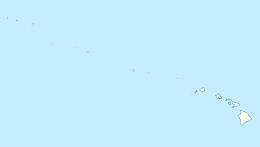 Satellite image of Kure Atoll (north is towards the upper-left corner) | |
| Geography | |
| Location | Pacific Ocean |
| Coordinates | 28°25′N 178°20′W / 28.417°N 178.333°W |
| Archipelago | Northwestern Hawaiian Islands |
| Total islands | 2 |
| Major islands | Green Island |
| Area | 0.884 km2 (0.341 sq mi) |
| Length | 5.8 mi (9.3 km) |
| Width | 4.8 mi (7.7 km) |
| Administration | |
| State | Hawaii |
| County | Honolulu County |
| Demographics | |
| Population | 0 (2012) |
| Additional information | |
| Time zone |
|


Kure Atoll (/ˈkʊəriː/; Hawaiian: Hōlanikū, lit. 'bringing forth heaven'; Mokupāpapa, 'flat island')[1] or Ocean Island is an atoll in the Pacific Ocean 48 nautical miles (89 km; 55 mi) west-northwest of Midway Atoll in the Northwestern Hawaiian Islands at 28°25′N 178°20′W / 28.417°N 178.333°W. A coral ring 6 miles (9.7 km) across encloses a lagoon several meters deep. The only land of significant size is called Green Island and is a habitat for hundreds of thousands of seabirds. A short, unused and unmaintained runway and a portion of one building, both from a former United States Coast Guard LORAN station, are located on the island. Politically, it is part of Hawaii, although separated from the rest of the state by Midway, which is a separate unorganized territory. Green Island, in addition to being the nesting grounds for tens of thousands of seabirds, has recorded several vagrant terrestrial birds, including snow bunting, eyebrowed thrush, brambling, olive-backed pipit, black kite, Steller's sea eagle and Chinese sparrowhawk. It is currently managed as a Wildlife Bird Sanctuary by the State of Hawaii's Department of Land and Natural Resource–Division of Forestry and Wildlife as one of the co-trustees of Papahānaumokuākea Marine National Monument with support from the Kure Atoll Conservancy.
Kure is seasonally inhabited by small crews of two to eight volunteers and biologists who work to restore and manage the native ecosystem.
Kure was discovered in the 19th century and was a common site of shipwrecks. In the late 20th century, it was home to a radio base that supported location finding, and in the 21st century it is mostly a nature reserve.
- ^ "Ua paʻa na inoa kahiko: Ancient Names Remembered" (PDF). Expand Papahānaumokuākea. Retrieved August 27, 2021.

